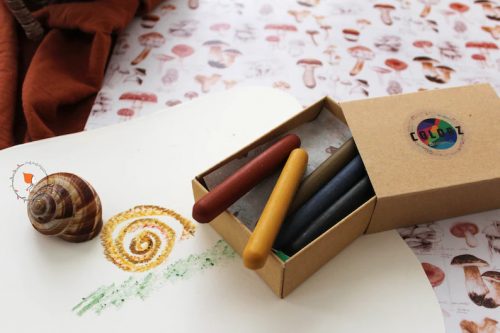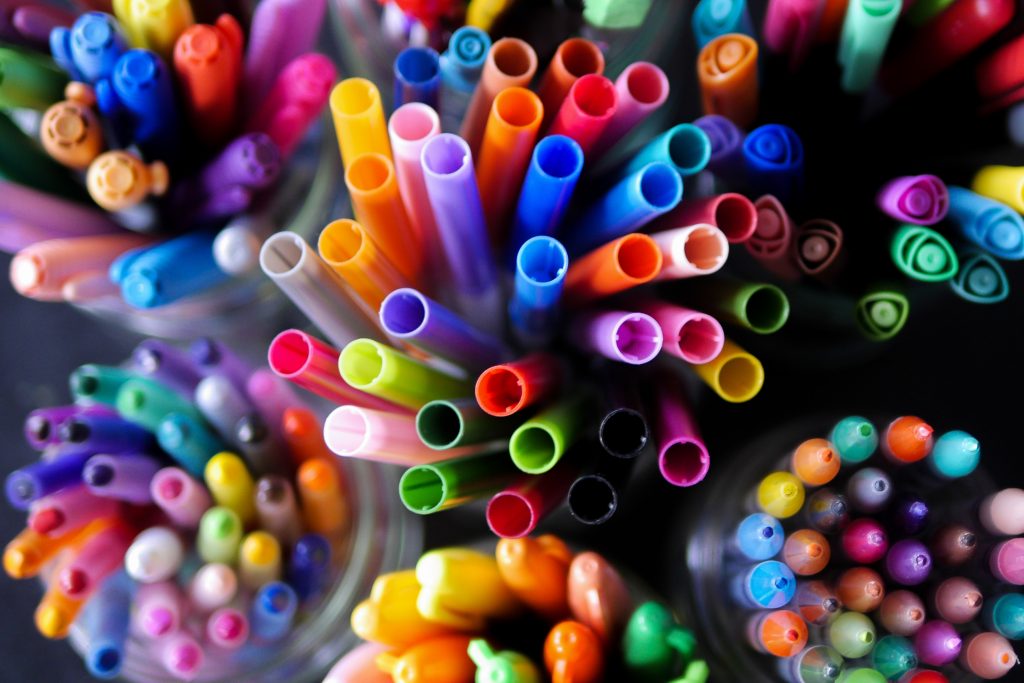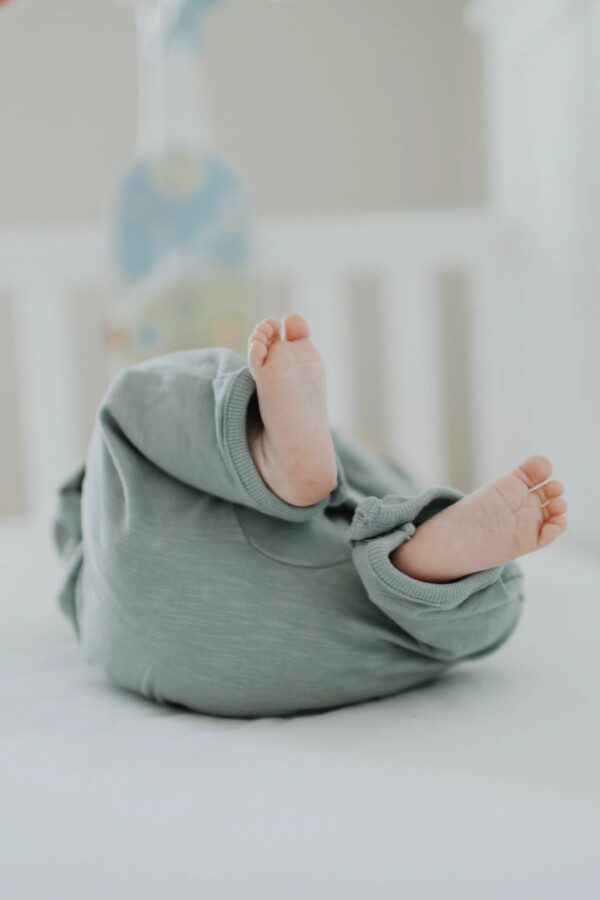Crayola is a classic children’s art supply company that’s been trusted by parents for over a century now. But with popular back-to-school items being found with toxic levels of phthalates, leads, asbestos, and more, some parents are left asking: are Crayola’s products actually as safe as they’re marketed to be?
So in this article, we’re going to dig into the ingredients and possible contamination in Crayola’s crayons, markers, and paint so that you can make the best decision for you and your family.
Table of Contents
- What Are the Ingredients in Crayola Crayons? Are They Really Non-Toxic?
- What’s the Deal with Paraffin Wax?
- What About the “Color Pigment”?
- Are Crayola Crayons Toxic If Eaten?
- TL;DR: Are Crayola Crayons Toxic?
- Better, Non-Toxic, Eco-Friendly Crayons
- Are Crayola Markers Non-Toxic?
- Are Crayola Markers Safe for Skin?
- Can Toddlers Use Crayola Markers?
- Are Crayola Markers Toxic to Dogs & Cats?
- Is Crayola Paint Toxic?
- Better, Non-Toxic Paint
- TL;DR: Are Crayola Crayons (& Other Products) Non-Toxic?
This post contains affiliate links, which means we may earn a small commission if you choose to make a purchase. We only make recommendations that are genuine and meet our ingredient/material safety standards.
What Are the Ingredients in Crayola Crayons? Are They Really Non-Toxic?
Just like a lot of other common household products (like Goo Gone and WD-40), the exact formulas for Crayola’s products are not publicly available because of their “proprietary nature.” While this may be more permissible for products like Goo Gone (which is mostly just used by adults), it’s unfortunate that we can’t get some more transparency when it comes to children’s products.
But, we’ll work with the information we’ve got to get an idea of how safe Crayola’s crayons, markers, and paint really are. So here’s what we do know about Crayola crayon ingredients according to their website: “The basic ingredients contained in Crayola Crayons are paraffin wax and color pigment.“
When asked for the exact ingredients, here’s what they say on their FAQ page:
“The exact ingredients of our products are proprietary, however, we are happy to provide you with the most common ingredient requests NOT FOUND in products currently manufactured by Crayola. This list does not include Crayola official licensed products. Please check packaging carefully to determine the manufacturer.
- Peanuts
- Tree Nuts
- Eggs & Egg Shell
- Milk
- Casein
- Whey
- Nut & Nut Oil
- Sesame & Sesame Oil
- Fish/Shellfish
- D&C Red Dye #40
- Latex*
*It is possible that latex gloves may have been worn during the manufacture and distribution of raw materials, components or finished goods.”
We reached out to Crayola to ask for more information and they gave us the exact same response as above. We’d love to see some more transparency here!

What’s the Deal with Paraffin Wax?
Paraffin wax is the primary ingredient used in Crayola crayons and is only one of the two ingredients they disclose. So let’s dig a little deeper into how safe this substance is.
You might know about paraffin wax because it’s the most common type of wax used in conventional candles. It is derived from petroleum, coal, or shale oil. This immediately causes some suspicion because nearly all petroleum-derived products come with a variety of potential health risks, especially when they build up in the body over a long period of time.
When paraffin wax candles are burned, they release toxic chemicals like benzene and toluene, which can pose health risks to those who breathe those chemicals in. Benzene and toluene are known carcinogens and can also cause headaches, nausea, respiratory problems, and birth defects.
BUT, you’re most likely not burning crayons! And this is good news, since most of the concern regarding paraffin wax comes from ingesting it, either through breathing in fumes or eating it.
So, as long as you’re not burning or eating crayons (more on the eating part below), you shouldn’t have to worry too much about the paraffin wax causing any serious negative health effects.
(On a related note: because it is derived from a non-renewable resource and requires heavy refinement and hazardous waste to produce, paraffin wax is NOT eco-friendly.)
RELATED: Non-Toxic Back to School Guide
What About the “Color Pigment”?
Crayola says that the other base ingredient used in their crayons is “color pigment.” This part is a bit frustrating because “color pigment” can mean so many different things!
Color pigments and dyes really run the entire gammat—some are completely safe, while others come with health risks. Unfortunately, we just don’t have enough information to make a solid determination on whether or not the color pigments in Crayola’s crayons are perfectly safe.
Crayola does, however, clarify that their products do not contain red dye #40, so at least you don’t have to worry about that one! (Keep reading for crayon brands that are more transparent about the types of color pigments used—many of the brands listed below use plant-based dyes.)
Body
3 Non-Toxic Pretend Makeup Sets for Kids & Toddlers
Most makeup contains chemicals that can disrupt your little one’s development. Plus—it’s messy! Here are some great non-toxic and plastic-free pretend makeup sets to play with instead.
Are Crayola Crayons Toxic If Eaten?
It’s not uncommon for kids (and pets) to eat crayons. Most people feel relatively safe allowing their little ones to handle Crayola crayons, but ingesting them involves absorbing a much higher concentration into their system. So many caregivers wonder: is it toxic for a baby, cat, or dog to eat a crayon?
According to Crayola’s website, even ingesting crayons should not cause harm. While it is of course a big relief that we don’t have to worry about any severe acute reaction, we would strongly recommend against allowing your kids and pets to eat crayons, for two reasons: overall toxic burden and potential contamination (primarily with lead).
Understanding Toxic Burden
The concept of total toxic burden (also referred to as body burden or toxic overload) is the idea that, although a substance may not cause harm on its own, all of the substances around us every day can add up to have a negative impact on our health.
So if you eat a Crayola crayon, you’re not likely to suffer any serious immediate effects (which is why they’re considered non-toxic). But when we add up all of the different petroleum-based products that we’re exposed to on a daily basis (along with other types of toxins), this is where things can add up to cause severe health problems in the long term.
This is also why taking small steps can add up to make a big difference in your and your family’s health!
And Then There’s the Contamination Issue
In addition to the toxic burden consideration, there’s another issue that can affect the safety of art supplies like crayons. In 2018, the U.S. Public Interest Research Group (PIRG) tested a variety of school supplies (like crayons, dry erase markers, 3-ring binders, spiral notebooks, rulers, lunch boxes, and water bottles) to look for toxins like lead, asbestos, phthalates, BTEX compounds (benzene, toluene, ethylbenzene, and xylene), and bisphenol-A (BPA).
They found that at least some of the crayons (specifically, the Playskool brand, which also markets its products as non-toxic) were contaminated with asbestos, which is a known carcinogen. Unfortunately, it’s unclear whether or not they tested any Crayola crayons. But considering that asbestos was found in one popular kids’ crayon brand, it isn’t out of the question that Crayola crayons could be contaminated as well.
Let’s Talk Lead
Most parents know that lead can be very bad for kids. The good news is that the laws that regulate the amount of lead allowed in children’s toys has gotten much stricter over the past several decades, which has helped to decrease the amount of illness and death suffered by lead-exposed children.
By law, crayons cannot exceed 90 parts per million (ppm) as a children’s toy. As Tamara at Lead Safe Mama discovered when she did her own tests, Crayola crayons test well below the legal limits for children’s toys.
However, the levels of lead Tamara found in the crayons were way too high according to the legal limits of lead allowed in food products. (Tamara argues that because crayons are so often ingested, they should actually be regulated using food standards instead of toy standards. We agree!)
If your little one is eating crayons, they could be ingesting a toxic amount of lead. This was the case for one 21-month old living in New York who suffered lead poisoning from eating crayons.
For this reason, we argue that Crayola crayons actually CAN be toxic when ingested, despite the fact that Crayola says otherwise.
TL;DR: Are Crayola Crayons Toxic?
When it comes to immediate or severe reactions to Crayola crayons, most parents don’t have to worry, as the base ingredients are free from common allergens and toxicants. However, the crayons CAN be toxic when eaten due to possible lead and asbestos contamination, as well as the potential long-term effects of ingesting petroleum-derived wax.
Better, Non-Toxic, Eco-Friendly Crayons
If you want to switch to crayons that do NOT use petroleum-derived paraffin wax and provide more transparency for their customers, we recommend switching from Crayola to the following non-toxic, eco-friendly crayon brands:
Honeysticks

Honeysticks crayons are made with sustainably sourced beeswax instead of paraffin and food-grade pigments instead of synthetics. They’re free from the top eight common allergens and are plastic-free, too!
eco-kids

eco-kids also carries petroleum-free wax crayons, which come in regular sticks as well as dinosaur eggs—fun! They use a mix of beeswax, soy, carnuba wax and use mineral pigments. These are made in the USA, too.
Mamamboo

If you’d prefer crayons that are not only petroleum-free but also vegan (beeswax-free), then check out Mamamboo. These are made from vegetable waxes and colored using mineral and plant-based pigments.
Filana

These crayons are made in a small factory in rural Colorado out of beeswax and other natural and organic waxes and pigments.
Big Little Universe

How cute are these non-toxic finger crayons? They come in a set that stacks on top of each other, and your child can practice their fine motor skills while wearing them. They’re tested for safety and certified according to CPSC international standards.
This set also comes with a coloring book, stickers, and a little tote to carry it all in.
And now, on to the next popular Crayola product: markers!

Are Crayola Markers Non-Toxic?
A lot of markers contain toxic chemicals like BTEX (benzene, toluene, ethylbenzene, and xylene) which can cause cancer, as well as damage to organs, immune system, and central nervous system. Many are alcohol-based as well, which means they should not be around kids who might put them in their mouths or draw on their skin with them.
For these reasons, you may want to stick to water-based markers for kids. The good news is that almost all markers that are marketed towards kids (like Crayola, Rose Art, Cra-Z-Art, etc.) are water-based and free from the most toxic ingredients like xylene.
But what are the exact ingredients in Crayola markers? Crayola carries a lot of different variations of markers: there are the Wonder Markers, the Pip Squeaks, the Ultra Clean Washable Markers, and the dry erase ones.
Here again, we have the same problem with a lack of transparent information about ingredients. They give us the basic info: “The basic ingredients in Crayola Markers are water and dye,” and then assure us that, like all of their other products, their markers are free from common allergens (as listed above).
Are Crayola Markers Safe for Skin?
Although we don’t have as much information as we’d like about the exact makeup of Crayola markers, you can rest assured that they’re much safer to use than other (non-kid-targeted) markers like Sharpies and EXPO dry erase markers. You’re not likely to get ink poisoning from drawing on yourself with a Crayola marker.
Can Toddlers Use Crayola Markers?
As long as they don’t have any specific sensitivities, your toddler should be safe using Crayola markers. While we don’t advise letting them put the markers in their mouth, doing so a few times shouldn’t likely cause any long-term damage.
Are Crayola Markers Toxic to Dogs & Cats?
The most toxic part of a marker for a pet is probably the plastic tube and lid. It could potentially cause them to choke or get stuck in their digestive tract. And then, of course, plastic is not good to ingest since it can potentially contain a wide range of toxins like phthalates, dioxin, and others. But those chemicals are more likely to affect someone over a long period of time, rather than from eating a couple of markers.
So while we highly suggest keeping any Crayola markers away from where your pets can reach them, they aren’t likely to suffer any immediate consequences from ingesting the marker ingredients themselves. But if your pet does ingest some markers, don’t be afraid to talk to your vet and keep a close eye on them during the following days just in case.
There aren’t really any alternative brands for markers (that we can find), so kid-focused brands like Crayola, Rose Art, and Cra-Z-Art are your safest bet for now.

Is Crayola Paint Toxic?
Children and chemically-sensitive people should be wary when using conventional oil-based paints, since they often contain chemicals like methyl alcohol (which can cause reproductive harm) and toluene (which can cause damage to the central nervous system). It’s also very common for paint to contain other toxins like heavy metals and high levels of formaldehyde.
Crayola paint is water-based and has been tested for the worst toxicants, so it’s definitely better than a lot of the paints available on the market. However, here again we have the issue of a total lack of transparency from Crayola about what is actually in their paint, so it’s impossible to know for sure how safe it is. (It’s worth noting that when asked about what types of dyes are used on their markers on their FAQ page, they completely avoid actually answering the question. It appears that page has since been taken down.)
Crayola makes acrylic, tempera, and washable paints, and the latter is likely the safest option. We recommend only allowing toddlers and young children to use Crayola paints with supervision in order to ensure they don’t ingest large amounts of it.
Better, Non-Toxic Paint
There are some brands that use natural and/or food-grade color pigments and other ingredients, and are much more transparent about their ingredients when compared to Crayola. Here are our favorite brands:
Honeysticks

Honeysticks carries vibrant watercolor paint that is free from paraffin wax, fragrances, or fillers and is dyed using food-grade color pigments.
eco-kids

eco-kids finger paints are made in the USA using food-safe, non-GMO ingredients (including potatoes, rice, and beans) and pigmented with organic fruit and vegetable extracts.
Natural Earth Paint

This face paint is made in the USA out of natural, organic, and safe ingredients that are free of nanoparticles, heavy metals, parabens, phthalates, formaldehyde, and petroleum-based pigments.
Wee Can Too

These finger paints are made with organic ingredients like fruit and vegetable powders and are wheat and dairy-free.
TL;DR: Are Crayola Crayons (& Other Products) Non-Toxic?
If your child or pet ingests one of Crayola’s crayons or markers, or a little paint, they’re not likely to have any serious or immediately adverse health effects. However, there is some concern about Crayola’s products when it comes to the lack of transparency about their ingredients, use of petroleum-derived materials, as well as potential contamination of things like lead. While you don’t have to worry too much about Crayola’s products, there are also some safer alternatives on the market when it comes to crayons and paint.






Tamara Rubin has found the cadmium in Honeysticks 2 colors, as well as in Filana.